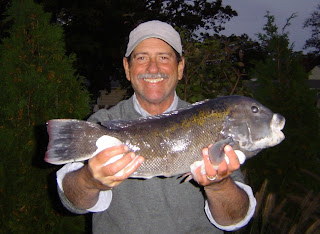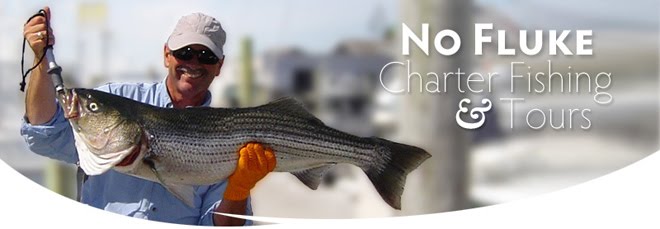 Captain Dave Monti with the eight pound tautog he caught near General Rock, North Kingstown, RI this Sunday using green crabs.
Captain Dave Monti with the eight pound tautog he caught near General Rock, North Kingstown, RI this Sunday using green crabs.Tautog fishing improving, here are nine tips
The tautog fishing is improving with larger fish being caught as the water cools. Tautog (or Blackfish) is a great eating fish with nice tasting white meat. Rhode Island’s Department of Environmental Management regulates recreational tautog fishing. The catch limit this time of year is six fish/person/day with a ten fish boat limit (the ten fish boat limit does not apply to charter and party boats). The season ends December 15.
Here are nine tips to help you have a great fall tautog season. Some have appeared in previous columns but are worth repeating.
1. Find structure to find tautog. Tautog can be fished from shore or boat and in both cases they like structure (rocks, wrecks, bridge piers, dock pilings, holes along the coast, etc.). So, no structure, no tautog.
2. Fish where the fish are. This is particularly true with tautog because they are a territorial species, you have to find the tautog. They are not going to find you. So if you get no bites move to another spot. When you find them, you find them and the bite is on.
3. Boat placement is important. Find structure, estimate wind/drift direction and anchor up current from where you want to fish and drift back to the spot as the anchor is setting. Once in position fish all sides of the boat. Ken Landry of Ray’s Bait & Tackle suggests casting a bit to cover as much area as you can. If still no bites let some anchor line out to change your position, if still no bites it is time to move the vessel.
4. Green crabs or Asian crabs are the baits of choice in the fall. When using green crabs make it easy for the tautog to bite and take the bait. Break off claws and legs, cut the crab in half and hook it through one leg socket and out another. Tautog rigs are simple many anglers prefer rigs with one hook.
5. Losing rigs is common when tautog fishing due to bottom hang ups on rocks and structure. To save tautog rigs, I use elastics to attach my sinkers so the elastic breaks when caught in structure and you same the rig. I also use egg sinkers depending on the conditions.
6. Fish lodged in structure. Here is a tip from George Poveromo’s “Rock’em Sock’em” article that appeared in this month’s issue of Saltwater magazine. When a fish is hooked and it has muscled its way back to structure, apply pressure forcing a respectable amount of bend in the rod. If the fish is not moving, pull or pluck the fishing line like a banjo or gaiter string. The sharp vibrations emitted work their way back down to the fish through the line and irritate it. The fish in a state of confusion may back out of the hole to free itself from the irritation. Once you sense this has happened start pumping and reeling in the fish so it does not muscle its way back into the structure.
7. Feel the bite… tap, tap and then get ready for a tug of war. I believe with the first tap the tautog is positioning the bait for consumption. So at the second or third tap I raise the rod up firmly feeling the weight of the fish (no need to jerk the rod up hard). Once the fish is hooked, keep the rod up and pressure on so the fish in not able to run for cover.
8. Use braid line with little drag. Braid line allows you to feel the fish tap. Monofilament line will stretch allowing the fish to run for cover, braid line does not stretch. It is important to put little drag on the reel and apply continuous pressure so the tautog comes up and does not go back down to hide in structure once you have it hooked.
9. Where to fish for Tautog. From shore look for rocky coastline like Beavertail Point on Jamestown, locations off Newport and off breakwater rock walls at South County beaches. From a boat I have had good luck at Plum Point light house next to the Jamestown Bridge, the rock jetty north of Coddington Cove in Portsmouth, off Hope Island, around Brenton Reef in Newport, Whale Rock, Ohio Ledge in the East Passage and any other place there is structure, debris, rock clusters, wrecks, etc.
Fly tying meeting/workshop
The monthly meeting of the United Fly Tyers of Rhode Island (UFTRI) will be held Wednesday, November 2, 6:30 p.m. at the Knights of Columbus Hall, 475 Sandy Lane, Warwick, RI. President Michael Maddalena said, “We instruct people on how to tie flies of all types, fresh and saltwater as many as five to six per month. This month the popular Peanut Bunker (or baby menhaden) fly will be one of six featured.” Association vice president Peter Burgess said, “The public is welcome to attend, we instruct at the beginner and intermediated levels… if you like participating our hope is that you will join the non-profit club for $30 per year. This includes all the supplies needed to tie at all monthly meetings.”
Banner year for young striped bass
Preliminary results from a 2011 survey conducted by researchers at the Virginia Institute of Marine Science (VIM’S) suggest the production of a strong class of young-of-year striped bass in the Virginia portion of Chesapeake Bay. The 2011 year class represents the group of fish hatched this spring. The results are good news for anglers who fish for this prized species. This year’s class is expected to grow to fishable size in three to four years.
Anglers have expressed concern over the health of the striped bass biomass with fewer fish being caught over the past three years, particularly those fishing in Narragansett Bay and along coastal shores. So the news is good as these fish migrate to Rhode Island and the Northeast. The 2011 study recorded more than 27 fish per seine haul, significantly higher than the historic average of 7.5 fish per seine haul. This is a significant increase from recent years, during which catches of young fish were average.
Although survey results show that numbers of young-of-year striped bass in Virginia have been average to above-average since 2003, results from a similar survey in Maryland indicate that numbers of juvenile striped bass there were below average in 2008, 2009, and 2010.
Where’s the bite
Striped bass bite is slow along southern coastal beaches this week. Ken Ferrara of Ray’s Bait & Tackle, Warwick said, “The striped bass and blues have followed the menhaden all the way up Apponaug Cove to my bait shop and all the way up to Post Road.” This weekend anglers enjoyed snagging the menhaden and then putting them right back into the school in hopes of catching a bass or bluefish. Some anglers were cutting them into chunks and weighting the line to send it down to the bottom. Bass fishing on the Southwest side of Block Island remains hot with many fish in the 30 and 40 pound range being caught.
Tautog fishing continues to improve. I caught four keepers at Hope Island and General Rock this Sunday. The largest fish was eight pounds. The eight pound fish took a green crab half in about fourteen feet of water. Francis Fleet reports a good tautog bite this weekend. This Sunday Connie Tu from West Warwick, RI caught five tautog including the nine pound pool winner.
Cod fishing is improving with anglers catching some fish in the teens with no large fish being caught yet reports the Francis Fleet.








